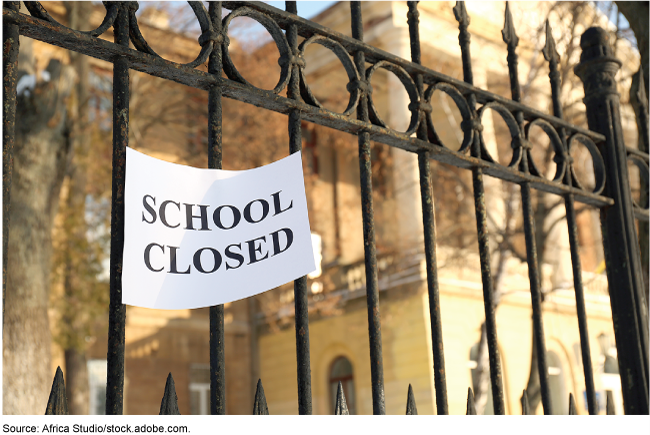College Closures: Education Should Improve Outreach to Borrowers about Loan Discharges
Fast Facts
When a college closes, students can be left with loans, no degree, and no path forward. Some students may be eligible for federal student loan forgiveness through a "closed school discharge" from the Department of Education.
But, some students still struggle with loans after a closure despite being eligible for relief. We found that outreach to potentially eligible borrowers can be confusing and may not be enough to connect with those at risk of default. Also, it can take months after a closure for some borrowers to be notified of their potential eligibility for a discharge.
Our recommendations address these issues.

Highlights
What GAO Found
Students affected by college closures may be eligible to have their federal student loans forgiven through a “closed school discharge” from Education. However, GAO found that outreach to student borrowers about their potential eligibility for a discharge 1) is not timely, 2) does not always contain complete information, and 3) misses opportunities to provide additional information to the borrowers who are most at risk for default. These practices do not align with Education's strategic goals for effective outreach and assistance to borrowers.
Key Issues with Closed School Discharge Outreach
|
Timeliness |
Because of Education's delays in identifying college closures, it can take several months after a closure until federal student loan servicers notify borrowers of their potential eligibility for a discharge, as required by the department. For example, Education did not identify a third of school closures from 2010-2020 until 2 months or more after the colleges actually closed. This means that borrowers who attended these colleges were not informed by their loan servicers about the discharge option until months after their college closed. These delays limit the ability of students to make timely and informed decisions about their educational and financial options after their college closes. |
|
Incomplete information |
GAO reviewed template letters that five loan servicers sent to inform borrowers of their potential eligibility for a discharge. GAO found that four of these servicers—who served over half of all borrowers—had information that was incomplete and potentially confusing. For example, letters from three of the five servicers were missing key information that would help borrowers make an informed decision about applying for a discharge, such as descriptions of the eligibility criteria or the discharge benefits. Education officials noted they do not provide loan servicers with guidance on what to include in these letters. As a result, eligible borrowers in need of loan forgiveness may not understand the information they are receiving. They may continue struggling to pay loans that are eligible for discharge. |
|
Missed opportunities |
After servicers notify borrowers about their potential eligibility for a discharge, limited additional outreach is provided to them. For example, Education does not currently instruct servicers to include information about discharges in the delinquency and default notices they send to borrowers. Call centers for the servicers GAO interviewed also do not proactively inform borrowers who call in that they are potentially eligible for a discharge. As a result, Education is missing opportunities to ensure additional outreach is provided to borrowers who are at risk of defaulting on loans that may be eligible for a discharge. |
Source: GAO analysis of Education data, Education and loan servicer documents and interviews. | GAO-22-104403
Why GAO Did This Study
When a college closes, it can derail the education of many students, leaving them with loans but no degree. Those who cannot complete their education may be eligible for a closed school discharge from Education, but borrowers may be unaware of this potential relief.
GAO was asked to review issues related to college closures. GAO's 2021 testimony focused on the number of affected borrowers and discharges (GAO-21-105373). This report examines whether Education ensures timely and sufficient outreach to borrowers after a closure. GAO analyzed Education data on colleges that closed from 2010-2020. GAO reviewed relevant federal laws, regulations, and documents from Education and five out of eight loan servicers of different types and sizes operating in 2021. GAO also interviewed Education officials and selected loan servicers.
Recommendations
GAO is making four recommendations, including that Education implement strategies to identify college closures in a timely manner, develop guidance for the information loan servicers include in the closed school discharge notifications, and ensure additional outreach is provided to at-risk borrowers who are potentially eligible for a discharge. Education identified steps it is taking or plans to take to implement these recommendations.
Recommendations for Executive Action
| Agency Affected | Recommendation | Status |
|---|---|---|
| Office of Federal Student Aid | The Chief Operating Officer of Federal Student Aid should implement additional strategies to identify college closures in a timely manner. For example, Education could leverage available data to identify potential closures, record known closures as soon as possible, and impose penalties on colleges that do not report closures. (Recommendation 1) |
Education neither agreed nor disagreed with this recommendation, but identified steps it would take to address it. Education explained how the new data system it is implementing in fall 2022 will facilitate faster reporting of school closures. Further, Education described its plans to review cases where a school failed to submit a timely report to determine whether to initiate fine actions and stated it expects that this approach will deter schools from failing to report closures in a timely manner. Education released a solicitation in May 2022 for a new servicing system that includes several provisions aimed at addressing various issues we identified in our report and recommendations, but Education officials said it is too early to commit to an implementation date since the contract has not been awarded yet. We will continue to monitor the development and implementation of the new servicing system and, as of December 2023, await Education's update.
|
| Office of Federal Student Aid | The Chief Operating Officer of Federal Student Aid should instruct loan servicers to use more frequent reports from Education on closures, such as the weekly reports, to send notifications to borrowers of their potential eligibility for a closed school discharge earlier. (Recommendation 2) |
Education neither agreed nor disagreed with this recommendation, but identified steps it would take to address it. Education released a solicitation in May 2022 for a new servicing system that includes a requirement for servicers to monitor college closures on a weekly basis to identify borrowers that may be eligible for a closed school discharge. We will continue to monitor the development and implementation of the new servicing system and, as of December 2023, await Education's update..
|
| Office of Federal Student Aid | The Chief Operating Officer of Federal Student Aid should develop guidance for what information loan servicers should include in the notification letters they send to borrowers after a school closure informing them about their eligibility for a discharge. (Recommendation 3) |
Education neither agreed nor disagreed with this recommendation, but identified steps it would take to address it. The agency released a solicitation in May 2022 for a new servicing system that includes a requirement for servicers to use a new notification letter template developed by Education that includes the key information we highlight in our report that borrowers need to make an informed decision. Education stated it has also shared the template with its current servicers. We will continue to monitor the development and implementation of the new servicing system and, as of December 2023, await Education's update.
|
| Office of Federal Student Aid | The Chief Operating Officer of Federal Student Aid should ensure additional outreach is provided to at-risk borrowers who are potentially eligible for a closed school discharge. At a minimum, this should include additional communication to borrowers with student loans in delinquency or default. (Recommendation 4) |
Education neither agreed nor disagreed with this recommendation, but identified steps it would take to address it. The agency released a solicitation in May 2022 for a new servicing system that includes a requirement for contractors to proactively remind borrowers about their eligibility and associated benefits of the loan discharge in all borrower communications, as well as a requirement for servicers to provide this information when an eligible borrower contacts the servicer's call center. These actions are positive steps that would benefit borrowers if Education implements the new servicing system. We will continue to monitor the development and implementation of the new servicing system and, as of December 2023, await Education's update..
|



